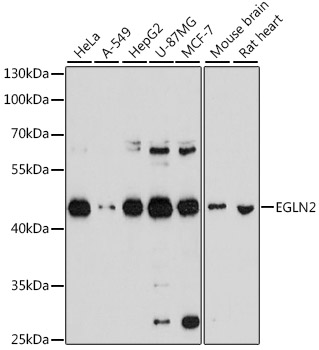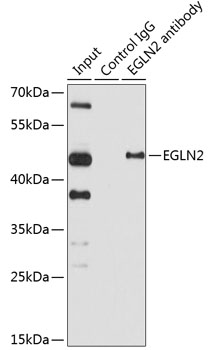-
Product Name
EGLN2 Polyclonal Antibody
- Documents
-
Description
Polyclonal antibody to EGLN2
-
Tested applications
WB, IP
-
Species reactivity
Human, Mouse, Rat
-
Alternative names
EGLN2 antibody; EIT6 antibody; HIF-PH1 antibody; HIFPH1 antibody; HPH-1 antibody; HPH-3 antibody; PHD1 antibody; egl nine homolog 2 antibody
-
Isotype
Rabbit IgG
-
Preparation
Antigen: A synthetic peptide corresponding to a sequence within amino acids 150-250 of human EGLN2 (NP_444274.1).
-
Clonality
Polyclonal
-
Formulation
PBS with 0.02% sodium azide, 50% glycerol, pH7.3.
-
Storage instructions
Store at -20℃. Avoid freeze / thaw cycles.
-
Applications
WB 1:500 - 1:2000
IP 1:20 - 1:50 -
Validations

Western blot - EGLN2 Polyclonal Antibody
Western blot analysis of extracts of various cell lines, using EGLN2 antibody at 1:1000 dilution.Secondary antibody: HRP Goat Anti-Rabbit IgG (H+L) at 1:10000 dilution.Lysates/proteins: 25ug per lane.Blocking buffer: 3% nonfat dry milk in TBST.Detection: ECL Basic Kit .Exposure time: 30s.

Immunoprecipitation - EGLN2 Polyclonal Antibody
Immunoprecipitation analysis of 150ug extracts of HeLa cells using 3ug EGLN2 antibody . Western blot was performed from the immunoprecipitate using EGLN2 antibody at a dilition of 1:1000.
-
Background
Cellular oxygen sensor that catalyzes, under normoxic conditions, the post-translational formation of 4-hydroxyproline in hypoxia-inducible factor (HIF) alpha proteins. Hydroxylates a specific proline found in each of the oxygen-dependent degradation (ODD) domains (N-terminal, NODD, and C-terminal, CODD) of HIF1A. Also hydroxylates HIF2A. Has a preference for the CODD site for both HIF1A and HIF2A. Hydroxylated HIFs are then targeted for proteasomal degradation via the von Hippel-Lindau ubiquitination complex. Under hypoxic conditions, the hydroxylation reaction is attenuated allowing HIFs to escape degradation resulting in their translocation to the nucleus, heterodimerization with HIF1B, and increased expression of hypoxy-inducible genes. EGLN2 is involved in regulating hypoxia tolerance and apoptosis in cardiac and skeletal muscle. Also regulates susceptibility to normoxic oxidative neuronal death. Links oxygen sensing to cell cycle and primary cilia formation by hydroxylating the critical centrosome component CEP192 which promotes its ubiquitination and subsequent proteasomal degradation. Hydroxylates IKBKB, mediating NF-kappaB activation in hypoxic conditions. Target proteins are preferentially recognized via a LXXLAP motif.
Related Products / Services
Please note: All products are "FOR RESEARCH USE ONLY AND ARE NOT INTENDED FOR DIAGNOSTIC OR THERAPEUTIC USE"
